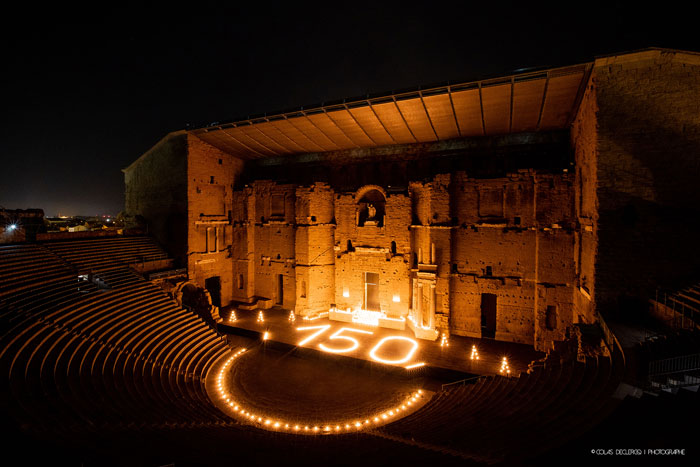
In the heart of France’s Rhône Valley, just north of the Provençal city of Avignon, is an open-air theatre which is regarded as one of the finest remnants of the Roman Empire. Included in the UNESCO World Heritage List, the Théâtre Antique is the best preserved theatre in Europe, and it’s here, every year, that the internationally renowned summer festival of the arts, Chorégies d’Orange, is held.
Some of the greatest names of lyric art have performed here, and this year, Chorégies d’Orange celebrates its 150th anniversary, with a programme which includes not only opera, but ballet, recitals and concerts – all celebrating the joy of musical expression.
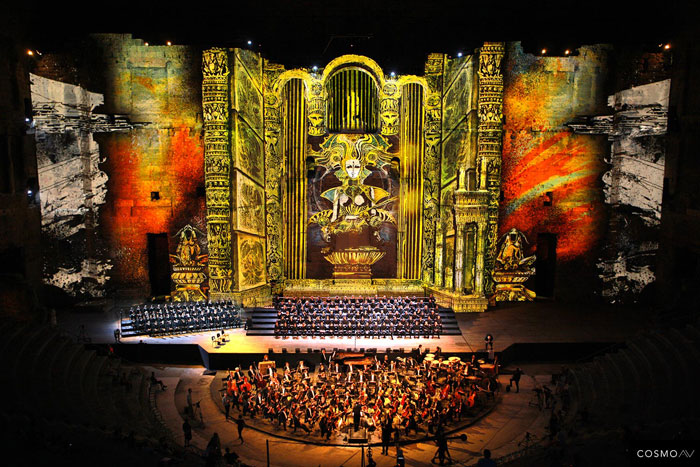
The Théâtre Antique was built as a venue for performances during Roman times – and now it hosts France’s oldest active festival, dating back to 1869. Performances are played out in front of the magnificent stage wall which Louis XIV described as “the finest wall in my kingdom”. The terraces, carved out of a hillside, can seat an audience of 8,300, and the acoustics are regarded as outstanding.
The first performance of the Chorégies d’Orange Festival in 1869 was Méhul’s opera, Joseph. At the time, the theatre was dedicated to performances of the French dramatic authors of the day, and also to the rediscovery of the great Graeco-Roman tragedies. In 1971, the ‘Nouvelles Chorégies’ were founded, and the Roman theatre embraced more ‘modern’ lyric and musical works – a highly successful decision.
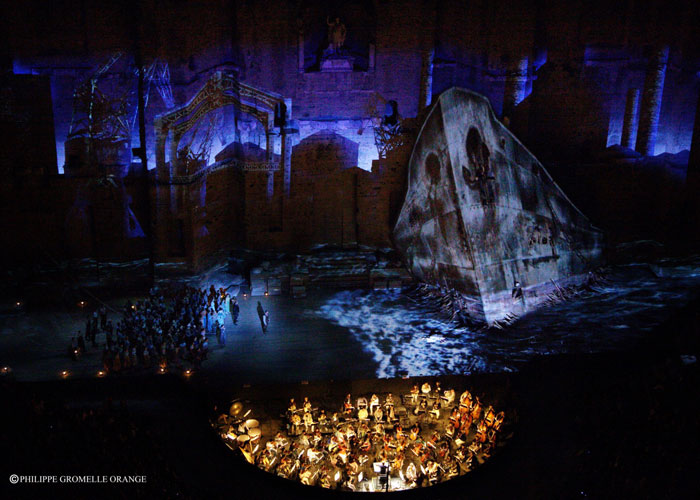
Although the theatre wall dates back to Roman times, the glass roof over the stage today is contemporary. The wooden structure and roof built by the Romans were destroyed by fire in the 4th century, and it wasn’t until 2006 that the existing glass canopy, which protects the ancient façade from the elements, was completed. It has been designed with an upward tilt, so that the sound soars out over the terraces.
The introduction to the Festival, the Mass of the Chorégies d’Orange, is held each year at Our Lady of Nazareth Cathedral. The original cathedral, which dated back to the 6th century, was severely damaged in 1561 during the religious wars, but later restored, and listed as a historic monument on 4th January, 1921. During the Festival, the Cathedral features Musical Hours for tourists, passers-by, or anyone who is interested, as well as performances by members of the choirs from each of the two operas on the programme.
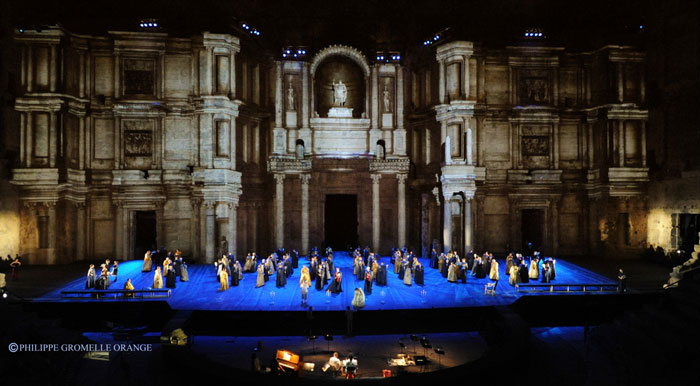
Jean-Louis Grinda, Director of the Festival, is keen to have as much diversity in the programme as possible, so in addition to opera, it features recitals, concerts, dance and a cinématic production.
This year’s Festival opened on 19th June, with the traditional Musiques en Fête des Chorégies d’Orange, a celebration of music in all its forms – from the traditional, to opera, to operettas and musicals – by some of the world’s greatest artists, and accompanied by some 200 musicians, performers and dancers. It was followed a few days later by Pop the Opera, a performance – by 600 middle and high school students from Provence Alpes Côte d’Azur – of a repertoire including some of the greatest opera choruses, the latest pop songs and themes from the cinema.
The first of the two operas to be presented at this year’s festival is Gioachino Rossini’s French-language opera, Guillaume Tell, based on Friedrich Schiller’s play William Tell, which itself drew on the legend of the Swiss folk-hero. Italian baritone Nicola Alaimo takes the title role, French soprano Annick Massis is Matilde, and Gianluca Capuano leads the Orchestre Philharmonique de Monte-Carlo, and the Chœurs des Opéras de Monte-Carlo et Toulouse, with choral co-ordination by Stefano Visconti.
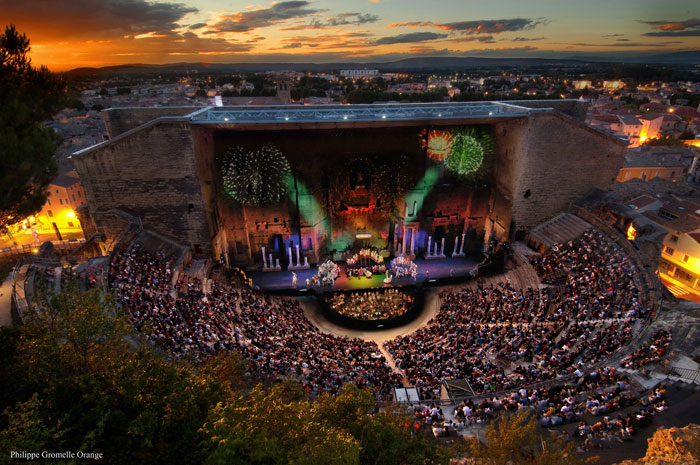
Mozart’s opera Don Giovanni – based on the legends of Don Juan, a fictional libertine and seducer – features bass-baritone Erwin Schrott in the title role. Rumanian bass Adrian Sâmpetrean is Leporello, and Donna Anna is sung by American soprano Nadine Sierra. A co-production with the Festival de Macerata, Don Giovanni is conducted by Frédéric Chaslin who leads the Orchestre de l’Opéra de Lyon and the Chœurs des Opéras d’Avignon et de Monte-Carlo, with choral co-ordination by Stefano Visconti.
In the only symphony concert of the Festival, Finnish conductor Jukka-Pekka Saraste leads the Orchestre Philharmonique de Radio France, and the Orchestre National de France, with the Choeur de Radio France, and the Choeur Philharmonique de Munich, in Mahler’s epic Symphony No 8, one of the largest-scale choral works in the classical concert repertoire. Known as the Symphony of the Thousand, it’s a fitting work for a celebratory season.
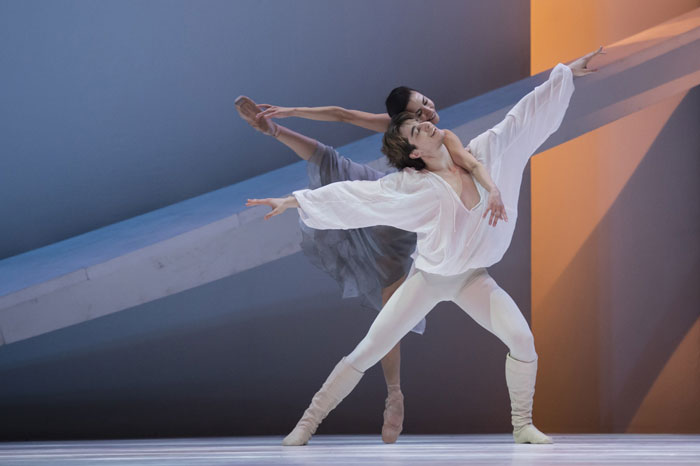
What more appropriate setting could there be for Les Ballets de Monte-Carlo’s production of Roméo et Juliette than the ancient Roman wall of the Théâtre Antique? Creator Jean-Christophe Maillot, the Company’s Artistic Director, says “We could almost imagine that we created Roméo et Juliette for Orange ….”. The action, which takes place in medieval Verona, lends itself so naturally to the setting. Set to Sergei Prokofiev’s sumptuous score, the performance will be danced to a recording by the Kirov Orchestra of Saint Petersburg, under the baton of Valery Gergiev.
One of the highlights of the Festival will be the debut at Chorégies d’Orange of Russian soprano Anna Netrebko and Azerbaijani tenor Yusif Eyvazov. Joined by Italian mezzo-soprano Daniella Barcellona, British baritone Christopher Maltman, a chorus and orchestra, Netrebko and Eyvazov – two of the world’s finest opera performers – present an evening of songs and duets by Guiseppe Verdi.

Nuit Espagnole is an evening of Spanish music and dance, starring soprano Ana María Martínez, tenor Ismael Jordi, and baritone Plácido Domingo, with dancers of the Antonio Gades Company and the Orchestre Philharmonique de Monte-Carlo, led by Óliver Díaz.
The Cour de Saint-Louis, now the courtyard of the Conservatoire d’Orange, is the venue for the Festival’s recitals. The first is by Mexican tenor, Ramón Varga, who has a repertoire which ranges from Italian classical songs to romantic German Lieder, and melodies by French, Mexican and Spanish composers from the 19th and 20th centuries. There’s another recital by Le Soleil de Naples, a trio of tenors – Giandomenico Cappuccio, Pasquale Ferraro and Vincenzo Di Nocera – from the Chorus of Monte-Carlo Opera, who share a passion for the joy and romance of classic Neapolitan song.
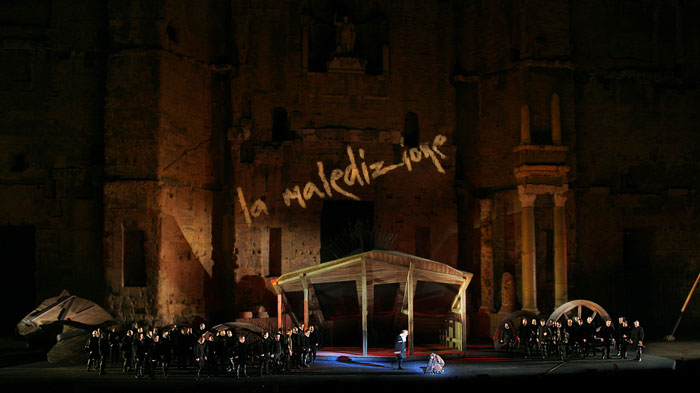
The Cour de Saint-Louis also hosts the Concert des Révélations classiques de l’Adami – an introduction to some of the upcoming talent of the future. Owing to the collaboration of the Artistic Association of the Adami with organizations such as Chorégies d’Orange, more than a hundred artists each year are introduced to the world of entertainment – artists representing classical music, jazz, dance, acting and conducting – and this concert features four operatic artists, with four classical musicians.
To further illustrate the spirit of diversity which Jean-Louis Grinda is introducing to the Festival, there’s a concert by American DJ Jeff Mills – the first DJ to have collaborated and recorded with a classical orchestra. Together with the Orchestra National d’Ile-de-France, conducted by Christophe Mangou, Jeff Mills presents Light From the Outside World.
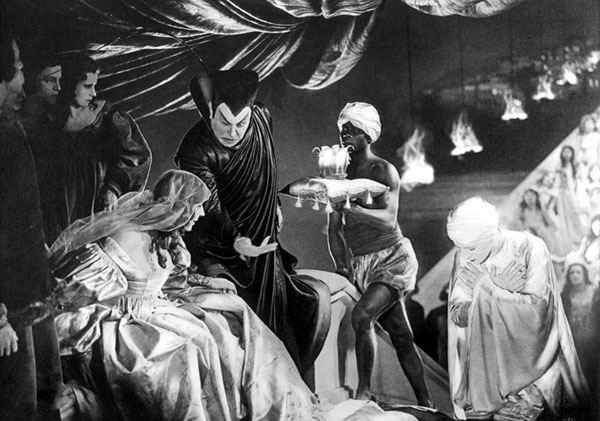
The ciné-concert is a recital entitled Faust, une Légende Allemande, which features the 1926 silent film, A German Folktale, directed by Friedrich Wilhelm Murnau, and set to music by Jean-François Zygel – French pianist, improviser, composer and improvisation teacher for piano at the Conservatoire de Paris. He is also known for introducing classical music programs on television and radio.
The 2019 Chorégies d’Orange runs until 6th August. For further information, visit the official website.
